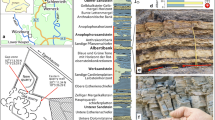Abstract
Podostemaceae occupy river rapids and waterfalls, where they attach to rocks in turbulent currents. All vegetative structures (roots, stems, leaves) are usually green and presumably photosynthetic, and highly variable in form among taxa. Here is reported the results of a study of a species of neotropical Castelnavia (C. noveloi). Published reports of the lack of roots in the species, as well as the presence of pinnately compound leaves, are challenged. Evidence based on early seedling growth indicates that prostrate roots develop exogenously from the hypocotyl base. After re-examining mature plants we interpret what was reported by earlier workers as pinnately compound leaves to be foliate roots. Examination of branching of mature shoots of C. noveloi indicate a form of sympodial branching system that is arranged in a dichasial order as helicoid, scorpoid, or fan-shaped cymes.




Similar content being viewed by others
Literature cited
Cook, C. D. K. & R. Rutishauser. 2007. Podostemaceae. Pp. 303–344. In The families and genera of vascular plants. K. Kubitzki (ed). Vol 9. Springer Verlag, Berlin.
Hiyama, I., R. Tsukamoto, R. Imaichi & M. Kato. 2002. Developmental anatomy and branching of roots of four Zeylanidium species (Podostemaceae), with implications for evolution of foliose roots. Annals of Botany 90: 735–744.
Jäger-Zürn, I. 1999. Developmental morphology of the shoot system of Podostemum subulatum (Podostemaceae – Podostemoideae): Part V of the series “Morphology of Podostemaceae”. Beiträge zur Biologie der Pflanzen 71: 281–334.
________. 2000a. The unusual ramification mode of Sphaerothylax abyssinica. (Wedd.) Warm. (Podostemaceae – Podostemoideae). Flora 195: 200–227
________. 2000b. Crustose roots and root-borne shoots of Zeylanidium olivaceum (Podostemaceae – Podostemoideae). Flora 195: 61–82.
________. 2002a. Comparative studies in the morphology of Crenias weddelliana and Maferria indica with reference to Sphaerothylax abyssinica (Podostemaceae: Podostemoideae). Botanical Journal of the Linnean Society 138: 63–84.
________. 2002b. Morphology and morphogenesis of ensiform leaves in Apinagia multibranchiata and Mourera fluviatilis (Podostemaceae – Podostemoideae). Flora 197: 394–407.
________. 2003a. Comparative morphology as an approach to reveal the intricate structures of the aquatic flowering plant family Podostemaceae. Recent Research Developments in Plant Science 1: 147–172.
________. 2003b. The architecture of Zeylanidium olivaceum (Podostemaceae) inferred from the structure of the primary shoots. Plant Systematics & Evolution 241: 103–114.
________. 2005. Morphology and morphogenesis of ensiform leaves, syndesmy of shoots and an understanding of the thalloid plant body in species of Apinagia, Mourera and Marathrum (Podostemaceae). Botanical Journal of the Linnean Society 147: 47–71.
________. 2008a. Morphological analysis of shoots and roots in Thelethylax minutiflora and T. insolata (Podostemaceae –Podostemoideae): taxonomic and evolutionary implications. Botanische Jahrbücher fur Systematik, Pflanzengeschichte und Pflanzengeographie. 127: 245–272.
________. 2008b. Morphology of Thelethylax isalensis (Perr.) C. Cusset (Podostemaceae – Podostemoideae). Botanische Jahrbücher für Systematik, Pflanzengeschichte und Pflanzengeographie 127: 273–283.
________. 2009a. The ramification of Apinagia riedelii: A key to the understanding of the plant architecture of Podostemaceae, subfamily Podostemoideae. Flora 204: 358–370.
________. 2009b. What is the dithecous leaf? An investigation of the neotropical Podostemum rutifolium subsp. ricciiforme (Podostemaceae – Podostemoideae). Edinburgh Journal of Botany 66: 469–481.
________. 2011. Neglected features of probable taxonomic value in Podostemaceae: The case of Polypleurum. Flora 206: 38–46.
________. & M. Grubert. 2000. Podostemaceae depend on sticky biofilms with respect to attachment to rocks in waterfalls. International Journal of Plant Science 161: 599–607.
Kato, M., S. Koi & Y. Kita. 2004. A new foliose-rooted genus of Podostemaceae from Thailand with a note on root evolution. Acta Phytotaxonomica Geobotanica 55: 65–73.
Koi, S. & M. Kato. 2003. Comparative developmental anatomy of the root in three species of Cladopus (Podostemaceae). Annals of Botany 91: 927–937.
________, R. Fujinami, N. Kubo, I. Tsukamoto, R. Inagawa, R. Imaichi & M. Kato. 2006. Comparative anatomy of root meristem and root cap in some species of Podostemaceae and the evolution of root dorsiventrality. American Journal of Botany 93: 682–692.
Mathew, C. J., C. B. Nileena & I. Jäger-Zürn. 2003. Morphology and ecology of two new species of Polypleurum (Podostemaceae) from Kerala, India. Plant Systematics and Evolution 237: 209–217.
Mohan Ram, H. Y. & A. Sehgal. 2001. Biology of Indian Podostemaceae. Phytomorphology, Golden Jubilee Issue: 365– 391.
Ota, M., R. Imaichi, & M. Kato. 2001. Developmental morphology of the thalloid Hydrobryum japonicum (Podostemaceae). American Journal of Botany 88: 382–390.
Philbrick, C. T. & C. P. Bove. 2008. A new species of Castelnavia (Podostemaceae) from Tocantins, Brasil. Novon 18: 94–98.
________, ________. & T. C. Edson, Jr. 2009. Monograph of Castelnavia (Podostemaceae). Systematic Botany 34: 715–729.
Rutishauser, R. 1997. Structural and developmental diversity in Podostemaceae (river weeds). Aquatic Botany 57: 29–70.
________ & M. Grubert. 2000. Developmental morphology of Apinagia multibranchiata (Podostemaceae) from the Venezuelen Guayanas. Botanical Journal of the Linnean Society 132: 299–323.
Sehgal, A., M. Sethe & H. Y. Mohan Ram. 2002. Origin, structure, and interpretation of the thallus in Hydrobryopsis sessilis (Podostemaceae). International Journal of Plant Science 163: 891–905.
Thiers, B. 2015, continuously updated. Index Herbariorum: A global directory of public herbaria and associated staff. New York Botanical Garden’s Virtual Herbarium. http://sweetgum.nybg.org/ih/
Uniyal, P. L. 2001. Some aspects of biology of Hydrobryopsis sessilis (Willis) Engl. (Podostemaceae). Beiträge zur Biologie der Pflanzen 72: 75–88.
van Royen, P. 1954. The Podostemaceae of the New World III. Acta Botanica Neerlandica 3: 215–263.
Weberling, F. 1989. Morphology of flowers and inflorescences. Cambridge University Press, Cambridge.
Acknowledgements
This work was supported by National Science Foundation Grant DEB-0444589 and Connecticut State University-AAUP research grants to C.T.P., and by Conselho Nacional de Desenvolvimento Científico e Tecnológico-Ministério de Ciência e Tecnologia (CNPq-MCT) to C.P.B.
Author information
Authors and Affiliations
Corresponding author
Rights and permissions
About this article
Cite this article
Jäger-Zürn, I., Philbrick, C.T. & Bove, C.P. The architecture of Castelnavia noveloi (Podostemaceae) – a re-investigation. Brittonia 68, 202–211 (2016). https://doi.org/10.1007/s12228-016-9408-6
Published:
Issue Date:
DOI: https://doi.org/10.1007/s12228-016-9408-6




